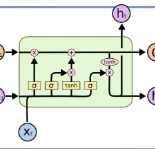Hybrid ventilation (coupling natural and mechanical ventilation) is an energy-efficient solution to provide fresh air for most climates, given that it has a reliable control system. To operate such systems optimally, a high-fidelity control-oriented model is required. It should enable near-real time forecast of the indoor air temperature and humidity based on operational conditions such as window opening and HVAC schedules. However, widely used physics-based simulation models (i.e., white-box models) are labour-intensive and computationally expensive. Alternatively, black-box models based on artificial neural networks can be trained to be good estimators for building dynamics. This paper investigates the capabilities of a multivariate multi-head attention-based long short-term memory (LSTM) encoder-decoder neural network to predict indoor air conditions of a building equipped with hybrid ventilation. The deep neural network used for this study aims to predict indoor air temperature dynamics when a window is opened and closed, respectively. Training and test data were generated from detailed multi-zone office building model (EnergyPlus). The deep neural network is able to accurately predict indoor air temperature of five zones whenever a window was opened and closed.
翻译:混合通风(结合自然和机械通风)是一种节能的解决方案,它能为大多数气候提供新鲜空气,因为它有可靠的控制系统。为了最优化地运行这些系统,需要采用高纤维控制模式。它应该能够根据窗口开关和高温空调仪表等操作条件,对室内空气温度和湿度进行近实时预报。然而,广泛使用的物理模拟模型(即白箱模型)是劳动密集型和计算成本高昂的。或者,基于人工神经网络的黑盒模型可以培训成为建筑动态的好测算器。本文调查多变量多头关注长短期内存(LSTM) 编码脱coder神经网络的能力,以预测装有混合通风装置的建筑物的室内空气状况。本研究使用的深神经网络旨在分别预测窗口打开和关闭时的室内空气温度动态。详细的多区办公大楼模型(EnergyPlus)生成了培训和测试数据。只要关闭了室内温度,深神经网络就能够准确预测五个区域的室内温度。





